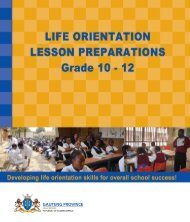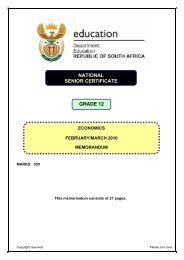Life Science Grade 11
Life Science Grade 11
Life Science Grade 11
You also want an ePaper? Increase the reach of your titles
YUMPU automatically turns print PDFs into web optimized ePapers that Google loves.
<strong>Grade</strong> <strong>11</strong> <strong>Life</strong> <strong>Science</strong>s Lesson PlansGRADE <strong>11</strong> SUBJECT <strong>Life</strong> <strong>Science</strong>s WEEK 8 TOPIC Animal diversity: Porifera, Cnidaria, Platyhelminthes Lesson 2LESSON SUMMARY FOR: DATE STARTED:DATE COMPLETED:Content: (CAPS p 41)With respect to the following phyla: Porifera, Cnidaria and Platyhelminthes discuss the following features of their body plan:• Symmetry and cephalisation;• The number of tissue layers developed from the embryo;• The number of openings in the gut;• Coloem and blood systems.LESSON OBJECTIVESThe learner must be able to:• Describe the type of habitat that sponges, Cnidarians and flat worms are found in• Explain the type of symmetry exhibited by the phyla Porifera, Cnidaria and Platyhelminthes.• Discuss the types of tissue layers that sponges, Cnidarians and flat worms possess.• Describe the type of digestive system found in the sponges, Cnidarians and flat worms.• Discuss the presence or absence of a coelom in the sponges, Cnidarians and flat worms.• Describe the type of blood system found in the sponges, Cnidarians and flat worms.• Name and example of a sponges, Cnidaria and flatworm.TEACHER ACTIVITIES LEARNER ACTIVITIES TIMING RESOURCES NEEDED1.1 Introduction• Refer to the previous two lesson and remind learners that abody plan for an animal includes symmetry, and tissue layers (theendoderm, mesoderm, and ectoderm in triploblastic animals andendoderm and ectoderm in diploblastic animals), the presence orabsence of a body cavity and the presence or absence of athrough gut.2.2 Main Body (Lesson presentation)Jigsaw group work. Divide the class into small groups of threelearners per group. Each group is to become an expert on one ofthe animal phyla: Porifera, Cnidaria or Platyhelminthes. Eachgroup is to use their text book to find information on their particulargroup of the following:• Symmetry and cephalisation;• The number of tissue layers developed from the embryo;• The number of openings in the gut;• Coloem and blood systems.•After 25 min the groups are to split up and reform into new groupsLearners listen to discussion, providing definitionsto the concepts: asymmetrical, bilaterallysymmetrical, radially symmetrical, diploblastic,triploblastic, coelom, blind gut and through gut.Learners work in expert groups gatheringinformation on the body plan of their particularphylum. Once they have the information theyform new groups where they share theirinformation and get information from experts onthe other two phyla.10 min25 minChalkboard/OHTSolutions for all p97-101Study and master p122-125Understanding <strong>Life</strong> <strong>Science</strong>s p 90-95• Internet reference for body cavities:• http://www.biodiversityexplorer.org/mm/sponges/• http://www.ucmp.berkeley.edu/porifera/porifera.html• Video from the Internet:• http://www.youtube.com/• Sea sponges under the sea• Images:• http://www.tutorvista.com/content/Term 1 Page 70© Gauteng Department of Education (CAPS version)







